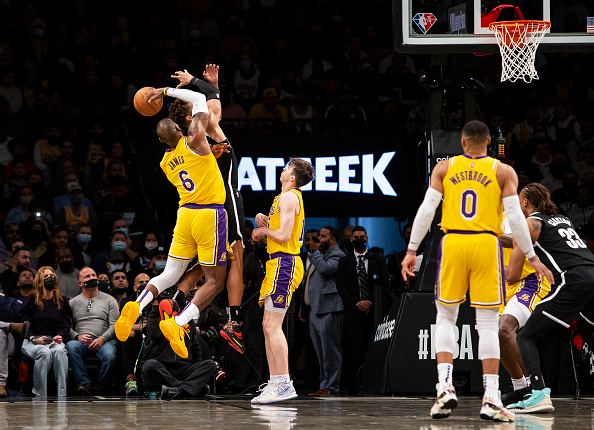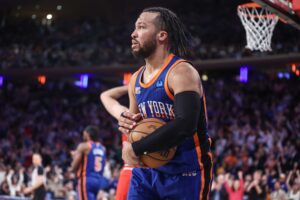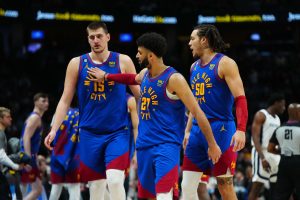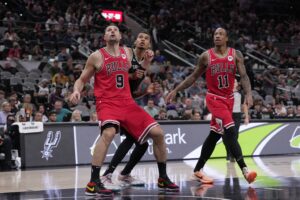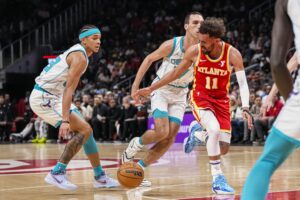With 21 games left in the regular season, The Los Angeles Lakers currently sit in 9th place in the Western Conference. LeBron James at 37 years young continues to defy the laws of time and is probably in the MVP conversation if the Lakers are having a better season. The Lakers’ offseason acquisition of guard Russell Westbrook hasn’t provided the boost they’d hoped for. Anthony Davis suffered yet another injury that’s likely to keep him out for most of the remainder of the regular season. Since Davis’ injury, the Lakers are 0-3. They’re only 2 games ahead of the Lillard-less Blazers and Zion-less Pelicans, and 3 up on the Spurs. Even the Kings remain within striking distance.
While it’s conceivable they can hang on and make the play-in tournament, The Lakers are toast. Can we blame LeBron for the Lakers’ failure this season?
The Lakers Are Toast. Can We Blame LeBron?
No Superstar(s) = No Championship
Winning a championship in the NBA is as hard as it is sometimes lucky. The 82 game regular season is a grind, and the playoffs up the intensity to new levels. Between injuries and COVID, a team can lose a few key pieces and fall out of contention practically overnight. Recent history has shown that a team isn’t winning an NBA title without at least one superstar on their roster. Of the 450 active players in the NBA, maybe 10-15 are bonafide superstars. And with 30 NBA teams, there simply aren’t enough superstars to vault every team into title contention.
In today’s NBA, we see superstars change teams with relative frequency. In some cases, teams who trade for a superstar immediately win a Championship. We saw it when the Toronto Raptors traded for Kawhi Leonard in 2018. It happened again the very next season when the Lakers dealt for Anthony Davis and won the title in the bubble.
In both of those scenarios, the teams’ respective front offices viewed their team as one piece away from contending for a title. They saw a brief and rare window of opportunity to acquire an elite top-10 asset. Most importantly, their GMs were willing to sacrifice their young talent and/or future draft capital in order to acquire that superstar and chase a championship. When a team leverages their future to acquire a superstar and they win, everyone is happy for a few months, maybe even a few years in a smaller market like Toronto. But not in Los Angeles. Not in the second-largest media market in the country. For Lakers fans, anything less than a deep playoff run is considered an abject failure.
How We Got Here – LeBron Comes to LA
LeBron James signed with the Lakers in 2018 as a free agent after his second stint in Cleveland. The Lakers had missed the playoffs in each of their previous 4 seasons. Adding James – a superstar – was supposed to reposition the Lakers as perennial title contenders. Late in his first season in LA, LeBron suffered a groin injury – the first major injury of his career – forcing him to miss the rest of the regular season. The Lakers would miss the playoffs for the 5th straight year.
LeBron hadn’t missed the playoffs since 2005 and had played in every NBA finals since 2010. His body had taken a beating during that 13-year stretch. The upshot of the Lakers missing the playoffs in 2018? Rest. James would have an actual offseason to allow his body to recover, a luxury he’d never had before. But even a rested LeBron needed more help. The Lakers roster was largely void of talent around him and they needed to retool their roster to compete for a title. They needed another Superstar.
Lakers Trade for Anthony Davis
During the 2019 offseason, the Lakers acquired superstar Anthony Davis in a blockbuster trade with New Orleans. Davis had long been unhappy with the middling Pelicans and wanted to join a contender. In exchange for Davis, the Lakers sent away Brandon Ingram, Lonzo Ball, Josh Hart, and their first-round picks in 2019, 2023 (pick swap with NO), and 2024.
Just to recap, that’s 3 young high-upside assets all under 25 years old and 3 first-round picks for Davis. It’s worth mentioning that the Lakers refused to include one young asset coveted by the Pelicans – Kyle Kuzma.
In their first season together in the NBA’s bubble, a rested LeBron and rejuvenated Davis led the Lakers to an NBA Championship. They both signed max extensions with the Lakers until 2023 and 2025, respectively. The new superstar duo appeared to just be getting started.
The Lakers 2020-2021 season ended in a disappointing first-round playoff exit to the eventual Western Conference Champion Phoenix Suns. Davis played in only 36 games due to injuries. LeBron once again was left carrying the team on his 35-year-old shoulders. And James, once again, asked the Lakers’ front office for reinforcements.
Lakers Trade for Russell Westbrook
During the 2021 offseason, the Lakers acquired Russell Westbrook in a trade with the Washington Wizards. In the trade, the Lakers gave up Kyle Kuzma, Montrezl Harrell, Kentavious Caldwell-Pope, and their 2022 first-round pick. Westbrook is owed $44 million this season, and his production has steadily declined from a year ago.
With LeBron, Davis, and Westbrook all on max contracts, the Lakers could only fill the remainder of their roster with veteran minimum deals. With Davis hurt – again – and the Lakers sitting in 9th place in the West, it’s obvious this deal hasn’t gone as hoped. At the trade deadline, reports surfaced of LeBron asking GM Rob Pelinka to find a trade partner for Westbrook. Pelinka either refused or failed to do so.
Lebron’s Hands Aren’t Clean
The Lakers’ trades for Davis and Westbrook have three key things in common.
First, they required the Lakers to relinquish the rights to players who would almost certainly form a more competitive roster around LeBron than the current Lakers roster does. Ingram, Ball, Hart, Harrell, Kuzma, and Caldwell-Pope [when healthy] all contribute meaningful minutes to their teams.
Second, they cost the Lakers significant first-round draft capital.
Third, and most importantly, LeBron James demanded that those trades happen. Even at the expense of the Lakers’ future.
LeBron & Pelinka
In the aftermath of the Westbrook trade that didn’t happen, LeBron’s frustrations with his GM Rob Pelinka have been well documented. James even went out of his way to praise Los Angeles Rams GM Les Snead for his willingness to forfeit first-round picks to acquire the talent they needed to win the Super Bowl.
Yet there’s a pretty straightforward explanation for why Pelinka and the Lakers decided to stand pat at the deadline – they’re out of assets. When you trade for a superstar and that player leads you to a championship, the assets you gave up to acquire that player are considered a sunk cost for success. But when you trade for a superstar who’s prone to injury like Davis – and in the case of Westbrook, a player who certainly hasn’t performed like a superstar while in LA – those deals loom large.
Can We Blame LeBron?
We can debate LeBron’s role in creating this scenario – or at least contributing to it – despite his claims of not “pushing the buttons” required for signing off on deals. But this is nothing new. James has been vocal about his teams’ personnel decisions throughout his career. He’s repeatedly spoken out when he feels his roster needs improving in order to make a run at a title. He did it in Cleveland twice. He’s done it in LA twice.
But this time, the Lakers’ cupboard of assets is bare. They’re all but certainly eliminated from title contention this season. The trades for an injury-prone Davis and a declining Westbrook – both done at the behest of Lebron James – have made sure of that.
[pickup_prop id=”20077″]
Main Photo
Embed from Getty Images


